The Scottish Health Survey 2021 - volume 1: main report
Presents results for the Scottish Health Survey 2021, providing information on the health and factors relating to health of people living in Scotland.
Chapter 9 Gambling
Chapter Summary
The proportion of adults undertaking any gambling activities in 2021 has decreased significantly since 2012, whilst prevalence of adult gambling activity excluding the National Lottery has changed to a lesser extent.
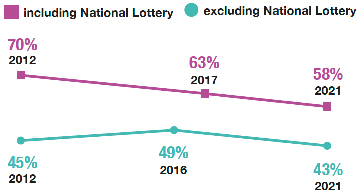
Men have consistently been more likely to gamble than women since 2012.
- 61% men in 2021
- 56% women in 2021
Online gambling participation has doubled since 2012.
- 7% 2012
- 14% 2021
The five most popular forms of gambling activity in 2021 were:
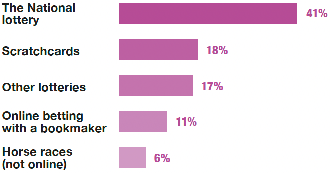
In 2021, gambling activity in the last 12 months varied by age, with the lowest prevalence amongst those aged 16-24 and highest for those aged 45-54 (35-44 when the National Lottery is excluded).
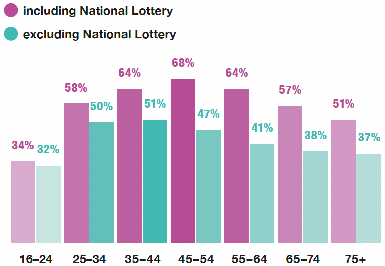
In 2021, men had taken part in more different gambling activities than women in the past 12 months on average.
- 1.5 for men
- 1.1 for women
Those aged 25-44 took part in the highest number of different gambling activities in 2021.
- 1.6 on average
In 2021, 8% of adults participated in four or more gambling activities in the last year.
More than double the amount of men participated in four or more gambling activities in the last year than women in 2021.
- 12% men
- 5% women
In 2021, adults who did not participate in gambling in the past 12 months had, on average, higher levels of mental wellbeing as measured by WEMWBS1 than those that did. After excluding the National Lottery, this difference increases.
- 49.6 Adults who do not participate in gambling
- 47.9 Adults who participate in gambling
- 47.4 Adults who participate in gambling excluding National Lottery
Women who gambled in 2021 had lower mental wellbeing than men who gambled.
- 48.6 Men
- 47.3 Women
In 2021, according to PGSI2 scores:
- 4.5% of adults were considered low risk gamblers
- 1.5% moderate risk gamblers
- 0.4% problem gamblers
Men were more likely than women to have a PGSI score that indicated they were a problem gambler in 2021.
- 0.7% men
- 0.1% women
1 WEMWBS scores range from 14 to 70. Higher scores indicate greater wellbeing.
2 The Problem Gambling Severity Index (PGSI). The scale runs from 0 to 27: a score of eight or over represents problem gambling. Scores between three and seven are indicative of 'moderate risk' gambling and scores of one or two are indicative of 'low risk' gambling.
Gambling
Erin Deakin
9.1 Introduction
Gambling behaviour is increasingly a subject of public health and policy interest in Britain. In the past decade, the gambling landscape in Britain has changed significantly. The public now has access to an unprecedented variety of gambling apps, websites, online games and lotteries and online gambling behaviour is constantly evolving, for example, individuals can now follow gambling companies on social media.[1] Gambling can have adverse impacts on the health and wellbeing of individuals, families, communities and society, such as loss of employment, debt, deterioration of physical and mental health and this can lead to increased risk of suicide among individuals affected by problem gambling.[2]
9.1.1 Policy background
Gambling legislation in Scotland is covered by the UK Gambling Act (2005),[3] which covers all forms of gambling, with policy responsibility held by the UK Department for Digital, Culture, Media and Sport. While gambling policy is a reserved matter, the Scotland Act 2016 gave Scottish Ministers limited powers to legislate on the number of Fixed Odds Betting Terminals in new betting shops only, but with the reduction of the maximum stake to £2, those very limited powers will effectively become null and void.[4]
The Gambling Act (2005),[3] which came into force in 2007, overhauled the way commercial gambling is licensed, advertised and regulated in the UK. It includes three core licensing objectives to:
- prevent gambling from being a source of crime or disorder, being associated with crime or disorder or being used to support crime,
- ensure that gambling is conducted in a fair and open way, and
- protect children and other vulnerable persons from being harmed or exploited by gambling.[5]
The Gambling Act 2005 is currently under review by the UK Government, following the increasing incidence of online gambling. Figures published by the Gambling Commission show an increase in online gambling from 18% in the year to June 2018 to 26% in the year to June 2022.[6]
9.1.2 Reporting on gambling in the Scottish Health Survey
This chapter presents estimates of past year participation in all forms of gambling in Scotland followed by estimates of problem and at-risk gambling according to the Problem Gambling Severity Index (PGSI).[7]
For a detailed description of both SIMD and age-standardisation as well as definitions of other terminology used in this chapter and for details on the data collection methods for gambling, please refer to Chapter 2 of the Scottish Health Survey 2021- volume 2: technical report.
Supplementary tables on gambling are also published on the Scottish Government website: Scottish Health Survey.
9.2 Gambling
9.2.1 Gambling activities in the last 12 months, 2012 to 2017, 2021, by sex
In 2021, more than half of adults reported taking part in any gambling activity in the previous year (58%), the lowest proportion since 2012 (70%), with levels ranging from 63% to 68% in the intervening years. While the National Lottery remained the specific form of gambling with the highest proportion, participation in this form of gambling decreased from 58% in 2012 to 41% in 2021.
While similar patterns in terms of an overall decrease were recorded by sex, gambling prevalence has consistently been higher amongst men compared with women since the start of data collection in 2012, with a gap ranging between five and ten percentage points recorded over the survey years.
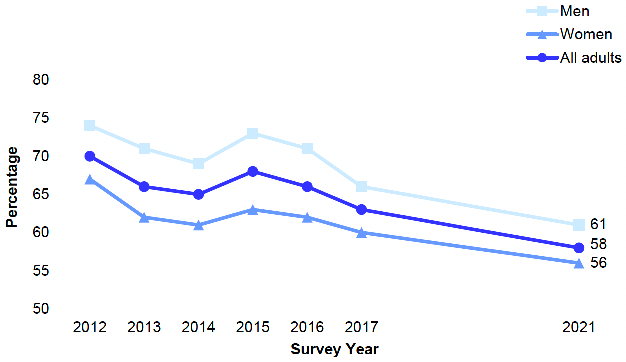
The trend for any adult gambling activity excluding the National Lottery has not been linear, with the highest levels of this type of gambling participation recorded in 2015 and 2016 (both 49%). However, the level in 2021 (43%) was the lowest level of participation since 2012 (45%).
While participation in any gambling activity has decreased over time, online gambling participation has risen overall from 7% in 2012 to 14% in 2021. However, this has remained at a relatively consistent level in recent years, ranging from 12% - 14% between 2015 and 2021. Similar patterns were recorded for both men and women. Figure 9A, Table 9.1
9.2.2 Gambling activities in last 12 months, 2021, by age and sex
The most popular gambling activity among all adults was purchasing tickets for the National Lottery draw (41%). This was followed by buying scratchcards (18%), other lotteries (17%), online betting with a bookmaker (11%) and horse races (not online) (6%). Each of the other gambling activities asked about in the survey had a prevalence of 5% or less.
The National Lottery was the most popular gambling activity amongst women in 2021, with nearly four in ten (39%) women having bought tickets in the last year. This was followed by purchasing scratchcards (20%), other lotteries (18%), bingo (not online) (5%) and online gambling on slots, casino or bingo games (5%). Each of the other gambling activities asked about in the survey had a prevalence of 4% or less amongst women.
Overall, a wider range of gambling activities were undertaken by men than women. The National Lottery (43%) and online betting with a bookmaker (18%) were the most popular gambling activities for men in 2021, followed by scratchcards (16%), other lotteries (15%), horse races (not online) (9%), football pools (7%) and sports events (not online) (7%). The remaining gambling activities had a prevalence of 5% or less amongst men.
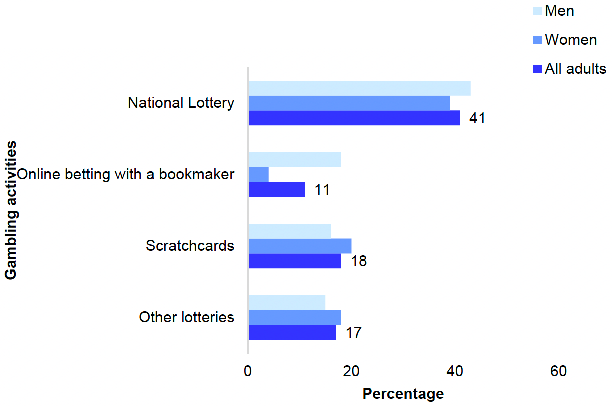
Men were more likely to have gambled online (excluding National Lottery) than women (20% and 9% respectively). Online betting with a bookmaker was the second most popular activity amongst men (18%) and sixth most popular amongst women (4%).
Participation in any gambling activity in the past 12 months varied by age, with the lowest participation rates recorded among the youngest and oldest age groups (34% of those aged 16-24 and 51% of those aged 75 and over), and the highest participation rates recorded amongst those aged 45-54 (68%). Men and women displayed similar age-related patterns of gambling participation.
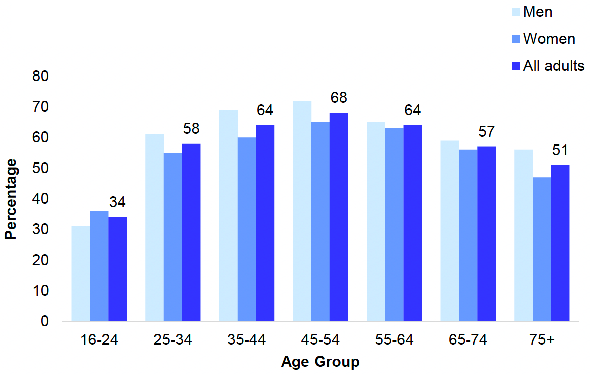
A different pattern by age was recorded for gambling participation excluding the National Lottery only. Prevalence of this type of gambling was highest among those aged 25-44 (50% - 51%) before gradually decreasing to 37% among those aged 75 and over. The lowest proportion for gambling activity excluding National Lottery only was recorded amongst those aged 16-24 (32%).
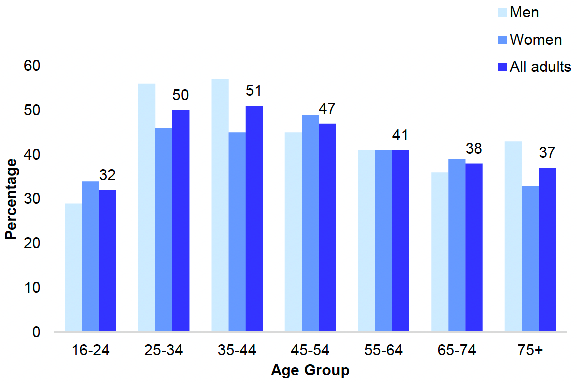
Different age-related gambling (excluding National Lottery only) patterns were recorded for men and women. This type of gambling activity peaked for men among those aged 35-44 (57%) whilst for women it was highest among those aged 45-54 (49%). Figures 9B, 9C and 9D, Table 9.2
9.2.3 Number of different gambling activities in last 12 months, 2021, by age and sex
On average, adults in 2021 took part in 1.3 gambling activities, with men (1.5) taking part in more activities than women (1.1). The mean number of gambling activities undertaken by all adults was highest amongst those aged 25-44 (1.6) while those aged 16-24 were least likely to have gambled at all (34%) and had taken part in the lowest number of activities (0.6).
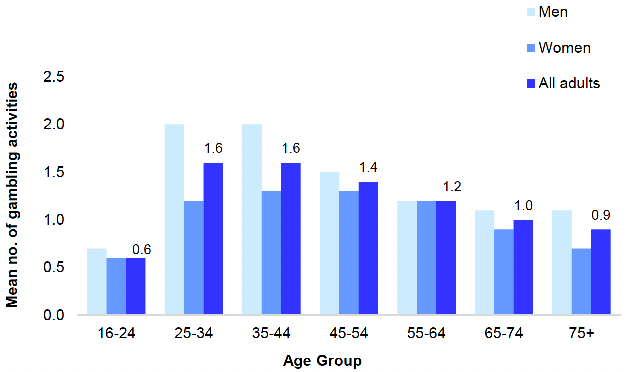
Men aged 25-44 recorded a higher mean number of gambling activities than women in the same age range (2.0 and 1.2 – 1.3 respectively). The difference in the number of gambling activities undertaken between men and women was narrower amongst older age groups.
Overall, 8% of adults participated in four or more different types of gambling activity in the last year with men more likely to do so (12%) compared with women (5%). Figure 9E, Table 9.3
9.2.4 Adult WEMWBS mean score, 2021, by gambling activities and sex
Overall, adults who did not participate in any gambling in the past year reported higher mental wellbeing scores on average compared with those who participated in any gambling activity and those who took part in any gambling excluding National Lottery only (mean WEMWBS scores of 49.6, 47.9 and 47.4 respectively).
Men who had taken part in any gambling activity had an average WEMWBS score of 48.6 compared with 47.3 amongst women who had taken part in any gambling activity. The WEMWBS score amongst men who took part in any gambling activity (excluding National Lottery) (48.1) was higher than amongst women who participated in this type of gambling activity (46.7). There were no significant differences recorded between men and women with regards to an absence of gambling activity participation or amongst those who took part in no gambling activity other than the National Lottery. Table 9.4
9.2.5 PGSI scores for gambling in the last year, 2021, by age and sex
In 2021, 0.4% of all adults recorded a PGSI score which indicated that they were a problem gambler. A higher proportion of men than women recorded a problem gambling score (0.7% for men, 0.1% for women).[8]
According to the PGSI scores, the prevalence of problem gambling varied by age but not significantly, ranging from 0% among those aged 65 and over to 1.0% among those aged 25-34 (1.9% of men in this age group).
Using PGSI scoring, in 2021, 4.5% of all adults were low risk gamblers and 1.5% moderate risk gamblers. Men were more likely than women to be low or moderate risk gamblers (5.5% and 2.1% respectively for men compared with 3.6% and 1.0% respectively for women). The highest proportion of moderate risk gambling was amongst men aged 25-34 (7.2%). Table 9.5
Table list
Table 9.1 Gambling activities in the last 12 months, 2012 to 2017, 2021, by sex
Table 9.2 Gambling activities in the last 12 months, 2021, by age and sex
Table 9.3 Number of different gambling activities in the last 12 months, 2021, by age and sex
Table 9.4 Adult WEMWBS mean score, 2021, by gambling activities and sex
Table 9.5 PGSI scores for gambling in the last year, 2021, by age and sex
The tables can be found on the main report page under supporting files.
References and notes
1. Gambling Commission (2018) Gambling Participation in 2017: behaviour, awareness and attitudes.
2. Gambling Commission (2019) National Strategy to Reduce Gambling Harms.
4. See Government to cut Fixed Odds Betting Terminals maximum stake from £100 to £2.
5. For further information see Gambling Act 2005.
6. Gambling Commission (2022) Statistics on participation and problem gambling for the year to June 2022.
7. Potenza, M. N., Fiellin, D. A., Heninger, G. R., Rounsaville, B. J. and Mazure, C. M. (2002). Gambling. Journal of General Internal Medicine 17: 721–732. doi: 10.1046/j.1525-1497.2002.10812.x.
8. In 2021, it was not possible to calculate a PGSI score for a small proportion of adults (1%) due to 'refused' or 'don't know' answers. This proportion excludes those for whom the gambling questions weren't answered at all (either on CAWI or by paper). This should be borne in mind when reviewing these results.
Contact
There is a problem
Thanks for your feedback